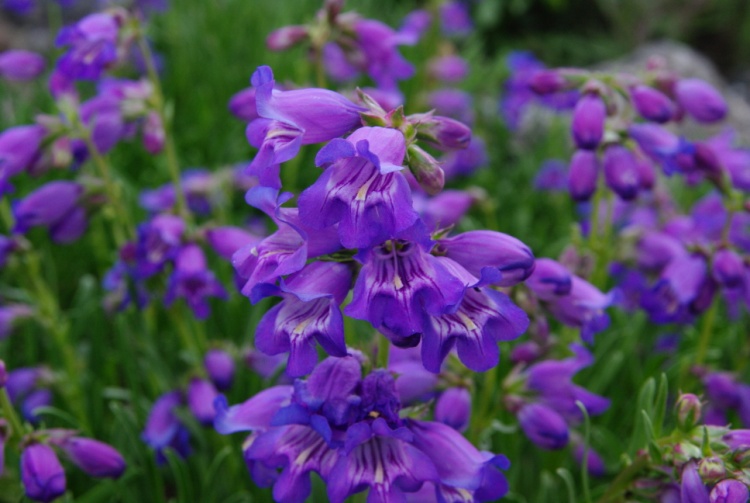Hall’s Penstemon in the Landscape

Stephen Love, University of Idaho
Scientfic Name: Penstemon halliiCommon Name: Hall’s penstemon, Hall’s beardtongue
Description: Hall’s penstemon is a short-statured, long-lived, herbaceous perennial. Short, stiffly upright flowering stems, to 8 to 10 inches tall, grow from a basal leaf mat. Disproportionately large flowers grow in dense, compressed clusters along the stems. The dark blue flowers are decorated with white throats and red-purple guidelines. Bloom period is 4 to 5 weeks long in May and early June. Although Hall’s penstemon is found only in the very high alpine areas of Colorado’s Rocky Mountains, the plants adapt very well to lower, warmer climates. This species makes a beautiful rock garden specimen and also contributes effectively in mixed beds and borders.
Native Habitat: Penstemon hallii is endemic to the Rocky Mountains of Central Colorado. It inhabits rocky, alpine meadows above tree-line at elevations ranging from 10,400 to 14,400 feet.
Cultural Requirement
Soil: Adapted to a range of soil types as long as they are well-drained. Can tolerate soils with moderate levels of organic matter and soils with high pH.
Moisture Tolerance: Although Hall’s penstemon exhibits drought tolerance, plants thrive under moisture conditions ranging from moderately dry to moderately moist.
Sun/Shade/Preference: Grows best in full sun but can tolerate light shade.
Transplanting: Withstands transplanting without serious issues, both from pot to pot and from pot to garden. Plants develop fairly rapidly and are suitable for pots up to 1-gallon in size.
Propagation: Relatively easy to grow from seed. Rate of germination is usually high, but may be low for some seed lots. Requires a 6 to 8 week cold stratification period to produce maximum germination. Easy to propagate using rooted cuttings under mist, but this method is seldom utilized.
Maintenance (pruning, fertilization, deadheading, division, irrigation, etc): Deadheading spent flowers will keep the basal leaf mat healthy and improve appearance. In very dry climates, supplemental irrigation, applied every two to three weeks in summer, is needed to maintain vigor and health. Low rates of fertilizer may occasionally be required to invigorate older plants.
Insect, disease, or other problems: Hall’s penstemon may periodically be infested with aphids on the flower stalks, but usually predator insects will take care of the problem without other control measures.
Landscape Value
Use in the Landscape: The dense, compact habit of Hall’s penstemon, combined with the dark blue flower color, makes it easy to place in the landscape. This species complements other short flowers and grasses in naturalized or formal rock gardens, beds, or borders and can effectively be used in front of taller shrubs and wildflowers. Hall’s penstemon is best planted with other flowering species that will contribute color after this spring bloomer is finished.
Weediness/Invasive Potential: Hall’s penstemon is clump forming and vegetatively non-aggressive. It rarely produces volunteer seedlings and lacks characteristics that result in a weedy habit.
Foliage: The dark green glossy leaves grow on very short caudices and form a dense, prominent basal mat. Leaf shape is long-ovate to broadly linear. Shorter, broader, bract-like leaves grow on the flowering stems but are not prominently visible. The foliage is attractive and healthy-looking all summer.
Flower: The dark blue, inflated flowers are on the large side for species in the Penstemon genus. The throat is wide open, making visible the white palette and the dark red-purple pollinator guidelines on the inside of the corollas. Flowers are densely clustered along short stems.
Timing: May-June.
Color:
Fruit: Upward facing globular capsules with sharp, stiff lobes on top. Each capsule holds numerous angular seeds.
Form: The low growth habit contributes a mounding habit, even when the upright flowering stems are present.
Texture: Moderately fine.
Ultimate Size: Pre-bloom the plants are typically less than 6 inches tall. In bloom, height increases to 8 to 10 inches. The basal leaf mat expands slowly each year, eventually reaching a diameter of 18 inches or more.
Rate of Growth: Foliage grows at a moderate rate, resulting in a healthy, attractive leaf mat the first summer. Sparse bloom may occur the first season after transplanting, but the first concentrated bloom must wait for the second year.
Suggested Plant Partners: Hall’s penstemon will complement a wide range of short-statured, moderately xeric companions. Suggestions include Heuchera cylindrica, Phlox kelseyi, Townsendia spathulata, Penstemon pinifolius, Zinnia grandiflora, Eriogonum kingii, Zauschneria garrettii, Aquilegia scopulorum, Festuca idahoensis, and Amorpha nana. Adds color in front of moderately sized, upright trees and shrubs, such as: Acer glabrum, Amelanchier alnifolia, and Ribes aureum.
Availability: Occasionally found as potted plants at local or mail order native plant nurseries. Seed can be purchased from native plant seed suppliers or the American Penstemon Society.
Cultivars: None.
References:

